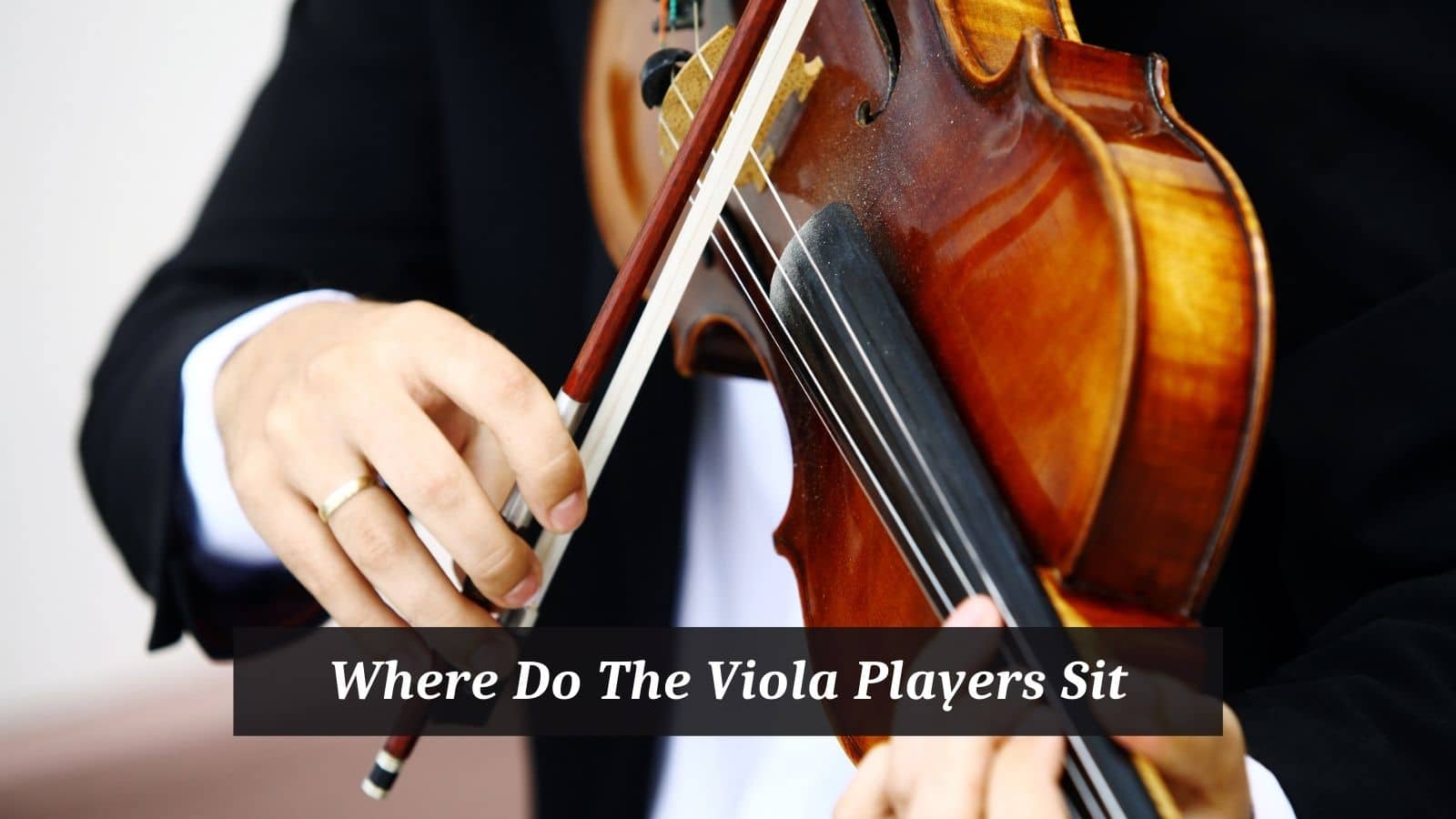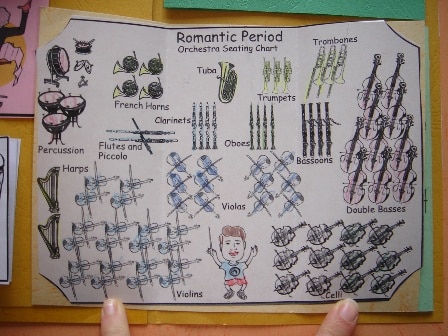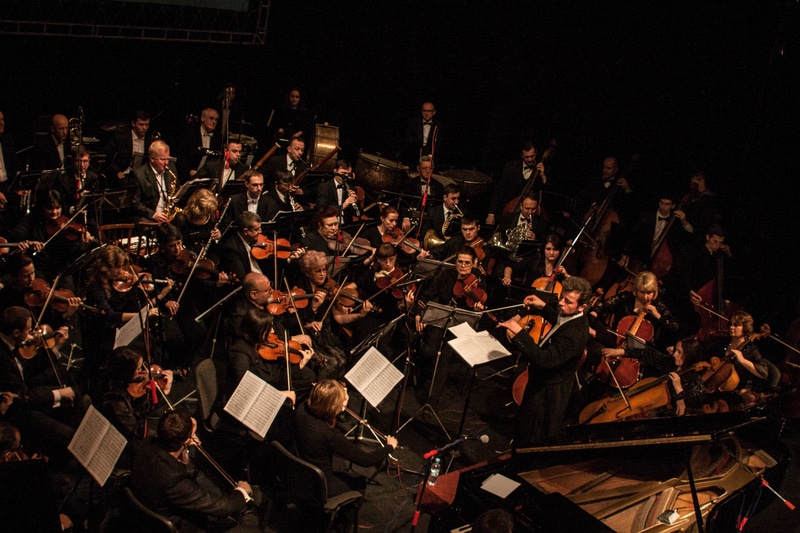
Most symphony orchestras nowadays follow the so-called ‘traditional’ seating layout, with the string section forming a semicircle in front of the conductor, cellos and basses on the right-hand side of the stage, followed by the violas and second violins, and finally the first violin section on the left side of the stage. Behind the string section are the woodwinds and brass.
But it wasn’t always like that, and even today, there are orchestras that do not follow this traditional layout.
Where Do The Viola Players Sit
Baroque Period
In the baroque period, conducting from the harpsichord was a common practice, and the harpsichord would be placed in the center of the orchestra. Baroque orchestras were much smaller than today’s symphony orchestras and consisted of violins, violas, cellos, basses, flutes, oboes, and trumpets.
The musicians would sit in a semicircle behind the harpsichord, with the violins on the left side, followed by the winds, and then the violas, cellos, and basses on the right side.
Classical Period
Moving forward to the classical period, a few more instruments were added to the orchestra, such as the timpani, bassoon, and French horn. The loudest instruments were always placed in the back so as not to overshadow the delicate sound of the string instruments.
Because the orchestra grew, some of the instruments required adaptations in order to match the volume and the tonal qualities of the other instruments.
The baroque flute, for example, which is made of wood, has a warm timbre, but it lacks projection and is not suitable for a larger ensemble. A modern flute is made of metal or metal alloys and was devised to improve its tonal qualities, especially its projection.
Romantic Period
The Romantic period sought more intensity and expressiveness in the sound. The timbre and volume of the baroque and classical periods were not enough for composers to convey their most intense emotions.
Because of that, the romantic period saw the advent of many new instruments or the adaptation of existing instruments to produce an even more powerful sound. But that required sonic balance and forced new layout plans to be devised.
Nineteenth century layout plans
George Henschel, for example, suggested in 1881 that the Boston Symphony Orchestra adopt a totally unconventional layout.
The violins and half of the cello section on one side of the stage, the second violins and the other half of the cello section on the other side of the stage, and violas in the center. The double basses would be split in half as well and placed behind the brass section.
It is pretty clear that the brass section (e.g., trumpets, trombones, and tubas) is the loudest section in the orchestra; therefore, it needs to be placed further back from the audience or else they would cover up the beautiful melodies of the violins.
However, famed 19th-century conductor Leopold Stokowski, for instance, once dared to place the winds and brass section of the Philadelphia Orchestra in front of the entire ensemble, which horrified the audience.
During the 19th century, it was common for orchestras to place the second violins opposite the first violins in order to create a stereophonic effect. It was Mr. Stokowski who rearranged the orchestra, creating what we call today the ‘traditional seating layout’.
The modern orchestra
From the romantic period on, the orchestras saw the advent of many new instruments, including the piano, trombone, tuba, harp, snare drum, cymbals, and mallet percussion instruments.
The orchestra grew in size, and today a typical full-size orchestra will consist of about 100 musicians. Of that, over half of the total number of musicians on stage belong to the string family.
Although the vast majority of symphony orchestras in the world have agreed to a standard seating layout, many orchestras are still experimenting with different seating plans.
To achieve a good sonic balance across the string section, approximately 12 violists are required on stage to match the rest of the string family, which consists of about 32 to 36 violins, 12 cellos, and 8 double basses.
Occasionally, a symphony orchestra will perform pieces such as Arnold Schoenberg’s Gurrelieder, which calls for 40 violins, 16 violas, 16 cellos, and 12 double basses. Different conductors might come up with different seating plans for such unusual pieces.
It is also important to mention that whenever you devise a new seating layout, you have to define where the principal players of each section will be seated as well.
Follow the leader
Each group of instruments (first violins, second violins, flutes, trumpets, etc.) has a leader, called a ‘principal’, who is responsible for defining bowings (in the case of the string section), playing the solos, ensuring connection across the different sections of the orchestra, evaluating new candidates during auditions and probationary periods, etc.
In the orchestra, the principal of a section is also the direct line of communication between the conductor and the rest of the section.
Inside/outside
String section musicians are seated two to a desk. That means that there will always be two musicians reading from the same music stand.
Violin, viola, cello, and double bass players sitting ‘inside’, that is, players seated on the chair that is placed farthest from the audience, will have slightly different responsibilities than the players sitting outside. Inside sitters will be responsible for turning pages, for example.
The principal players always sit outside
If you are the principal viola or another outside viola player and your orchestra uses the traditional seating layout, you will be seated on the chair closest to the cellos.
However, if your orchestra uses a non-standard seating chart with the viola section to the left side of the conductor, the “outside” chair will be the chair closest to the first violins.
Conclusion
Even though a standard seating plan has been defined and adopted by the vast majority of orchestras across the globe, some orchestras adopt a different seating layout.
In some orchestras, violists will sit opposite the first violin section, i.e., to the right of the conductor. In other orchestras, violists will sit next to the first violin section, i.e., where the second violin section would typically be placed.
It is also not uncommon for conductors to change the seating layout of an orchestra from time to time.
So, if you are a violist, you should be aware of the seating plan of your orchestra, especially after passing an audition or when playing with a new orchestra for the first time.


